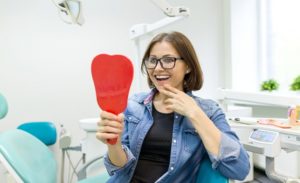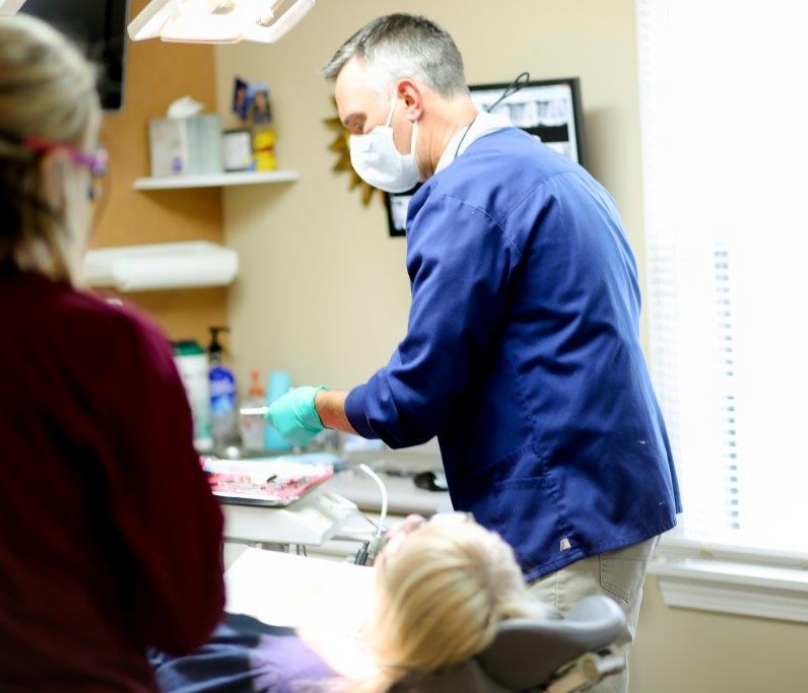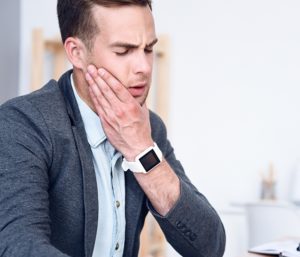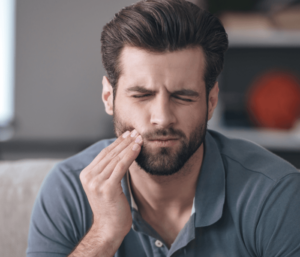J. Peter St. Clair, DMD Blog
DENTAL INSURANCE – PART 2/3
August 1, 2022
 Last week I explained how dental insurance works in general, and why there is no “good” dental insurance. This week I will break down the general differences between dental insurances, offer some things to consider when using your dental insurance, and when it makes sense to consider purchasing insurance if you don’t have it.
Last week I explained how dental insurance works in general, and why there is no “good” dental insurance. This week I will break down the general differences between dental insurances, offer some things to consider when using your dental insurance, and when it makes sense to consider purchasing insurance if you don’t have it.
We get asked just about daily by patients who are either self-employed or are not offered insurance through their employer, “Should I consider getting dental insurance?” In most cases, it does not make sense to purchase dental insurance on your own. This goes back to last week’s column as to how dental “insurance” is set up to begin with.
As discussed last week, all dental insurance companies set a limit as to how much they will “pay-out” on an annual basis. The industry average is $1000 per year, which has not changed since the inception of dental insurance back in the 1970’s. The premiums for individual dental insurance run around the $700 range. This leaves the patient with a net gain of $300 from the insurance company. This especially does not make sense if you typically only have your teeth cleaned a couple of times a year. The only way purchasing your own insurance may make sense is if you are looking to cover your entire family. You should discuss these factors with your dental office prior to making the decision. Key: You should be the one to make the decision who you pick as a dental provider, not an insurance company that might be a different company or have a new set of rules next year.
In dentistry, there are a few types of dental insurance available. There are “open” insurance plans, where patients can go to whoever they want and a certain percentage of the fee will be covered depending on the procedure. The other types of insurance are PPO’s, HMO’s and discount plans or “clubs”. With these types of insurance, the dentist has to sign a contract with the insurance company and abide by a pre-set limit they can charge for all procedures. While this may sound good from a patient perspective, there are other things to consider.
Many private dental offices are being bought-up by larger corporations across the country. In general, the business model of these practices is to see a higher volume of patients to do more procedures. There will be less and less privately-owned dental practices as time goes on. However, in our area right now, most dental offices are small businesses. The decision for the dentist to sign-up for a particular plan depends on many factors.
As a consumer, and patient, you have to be the one to decide what is important to you. Keep in mind that dentistry is not a commodity. Dentistry should be relationship based. Approaching it this way will give you the best opportunity to get the level of care that is right for you.
Please keep in mind: Insurance does not equal health. Health requires investment and personal responsibility. Better access to care across the general population is a topic for another time. Right now, you have full control in managing your dental health care. You should talk to your dental office about any concerns you have.
Next week I will discuss the costs of dental care for those with or without dental insurance and ways to get what you want with regards to your dental health.
Dr. St. Clair maintains a private dental practice in Rowley and Newburyport dedicated to health-centered family dentistry. He has a special interest in treating snoring, sleep apnea and TMJ problems. If there are certain topics you would like to see written about or questions you have, please email them to him at jpstclair@stclairdmd.com
DENTAL INSURANCE – PART 1/3
July 25, 2022
 As you can imagine, most dental offices are bombarded daily with questions about dental insurance. “Do you take my plan? How much is covered? Why is dental insurance coverage so bad?” These are just a few of the questions we hear daily. So, why is dental insurance the way it is?
As you can imagine, most dental offices are bombarded daily with questions about dental insurance. “Do you take my plan? How much is covered? Why is dental insurance coverage so bad?” These are just a few of the questions we hear daily. So, why is dental insurance the way it is?
Dental insurance was first offered back in the early 1970’s. Back then, the first insurance companies offered a yearly maximum benefit level of $1000 per year per patient. In 2019, those insurance companies, and many others, offer an average yearly benefit of $1000 per year. Yes, you read that correctly; it has not changed. However, back in the 70’s you could have gotten a lot more dentistry than you can today for that same $1000. Why hasn’t it changed?
There are many answers to this question. The bottom line is that raising the dental insurance limits would be extremely unprofitable for insurance companies. Here are some reasons why.
First is the “use” factor. Many patients who have dental insurance use their insurance right up to that yearly maximum. This is generally not the case with other types of insurance. In fact, the entire dental insurance model is based on a certain percentage of those insured not using their benefits at all. If the yearly benefit was higher, the premiums would need to be much higher for the insurance companies to make a profit. This would destroy the model and there would be many fewer patients signing up for those plans.
The second reason is pre-existing conditions. Many dental problems are often ignored for years and patients will often wait until they have “insurance” to take care of their problems. This is why many insurance companies have a “wait period” for certain dental procedures. When that patient finally has dental coverage and the dentist tells them they need three root canals and three crowns they are shocked to hear that their insurance will only cover a small percentage of the treatment. There is no dental insurance available to cover situations like this because it would be extremely unprofitable for the insurance companies.
Next is the fact that dental problems are much more common than many other health problems. This goes back to my first point – the “use” factor. Look at how expensive medical insurance is. For many people, they may go for routine check-ups to their doctor, but a much lower percentage of patients use their insurance for more costly procedures. However, we all need the health insurance in case of that catastrophic event that would otherwise bankrupt us. For dental insurance companies to remain profitable they have to charge a high enough rate to offset the “people using it” factor, but also a rate low enough for it to be “worth it” for the typical consumer.
So, in reality, we are all sort of stuck with the way it is. To provide “full coverage” for dentistry, insurance companies would have to charge more for premiums than most people would deem worth spending. This situation is unfortunate but there is no end in sight to combat this.
Next week I will expand on this with a discussion of the difference between the different kinds of dental insurance available: those you can go to whoever you want and those where you may be asked to pick a dentist from a list.
Dr. St. Clair maintains a private dental practice in Rowley and Newburyport dedicated to health-centered family dentistry. He has a special interest in treating snoring, sleep apnea and TMJ problems. If there are certain topics you would like to see written about or questions you have, please email them to him at jpstclair@stclairdmd.com
LESSONS LEARNED
July 18, 2022
 I have focused the majority of my career on family preventive and general dentistry. While I enjoy most aspects of what I do, I firmly believe that a good percentage of dental problems are avoidable, which means that dentists shouldn’t be as busy as we are with routine fillings, removal of teeth, and many other procedures. While there are other factors at play, such as genetics, personal responsibility is often at the head of the pack.
I have focused the majority of my career on family preventive and general dentistry. While I enjoy most aspects of what I do, I firmly believe that a good percentage of dental problems are avoidable, which means that dentists shouldn’t be as busy as we are with routine fillings, removal of teeth, and many other procedures. While there are other factors at play, such as genetics, personal responsibility is often at the head of the pack.
Prevention often takes a back seat to fixing problems. Decayed, broken and worn teeth all had nothing wrong with them at some point. Granted, you have to fix what is already broken, but “How could it have been prevented?” has always been the question I ask myself, and try to make my patients understand.
What are the factors at play for the 6 new cavities? What could have been done to avoid the wearing-down of all the teeth? Could anything have been done during growth to alter how the airway develops? What factors are causing the chemical erosion of the teeth? These are important questions to be considered.
Much of what is being marketed to dentists today is technology; 20 years ago, it was cosmetics. The technology available today in dentistry is really cool, just like the technology available in most other areas of our lives. There are some things I would not want to live without since adding them to our office; digital x-rays, digital scanning instead of messy impressions, computer-generated restorations, telemedicine, etc. However, how much technology do we really need if we avoid the problems in the first place?
Let me give an example. If I had to pick the single most important “technology” that has impacted dentistry in the last 30 years, it would be dental implants. Grafting of bone and dental implants have changed the lives of many people, who would otherwise have been forced to wear something removable in their mouth to replace teeth. And, while this is a great service to patients, I’m still always thinking, “What are the lessons I have learned to help my next patient avoid needing all this dentistry?”
More dentists are being trained to place dental implants, not only to replace one missing tooth, but to replace ALL the teeth. You may have seen the commercials from a large dental franchise with stories from “real” patients who have had dental implants change their lives. What they don’t tell you is that they remove all the teeth, even ones that can be saved, remove a ton of bone to be able to place 4-6 dental implants, to then have a piece of plastic with plastic teeth screwed to it. They claim – “You can put an end to dealing with missing teeth or repetitive dental work with dental implants.”
You have to go in for the consultation to find out that upper and lower “All-on-4” dentures attached to implants will run you $60K+. They also fail to mention in any of the advertising that there is maintenance that can be costly. And, they don’t really feel like teeth. While this treatment may be acceptable for some patients, the clear choice is to avoid it.
Keeping your natural teeth makes much more sense. Improving and maintaining any part of our health requires time, commitment and resources. There are many great dentists out there to help you maintain your teeth for a lifetime.
Dr. St. Clair maintains a private dental practice in Rowley and Newburyport dedicated to health-centered family dentistry. He has a special interest in treating snoring, sleep apnea and TMJ problems. If there are certain topics you would like to see written about or questions you have, please email them to him at jpstclair@stclairdmd.com
UNDERSTANDING YOUR BENEFITS
July 11, 2022
 I think it is safe to say that our healthcare system has some flaws. Wouldn’t it be nice to have a healthcare system that realized that everything in the body is connected? Unfortunately, there are no reasonable solutions for this in the near future. Therefore, it is important for you to take your health into your own hands and plan appropriately.
I think it is safe to say that our healthcare system has some flaws. Wouldn’t it be nice to have a healthcare system that realized that everything in the body is connected? Unfortunately, there are no reasonable solutions for this in the near future. Therefore, it is important for you to take your health into your own hands and plan appropriately.
Patients will sometimes balk at treatment not covered by their dental insurance. Dentists will often hear, “Just do what my insurance covers. I don’t want anything extra.” In fact, a recent ADA poll showed that a lack of dental insurance was the #1 reason most patients gave for not visiting a dentist. Here are some frequent questions patients often ask about dental insurance.
Why doesn’t my insurance cover all of the costs for my dental treatment?
Dental insurance isn’t really insurance (defined as a payment to cover the cost of a loss) at all. It is a monetary benefit, typically provided by an employer, to help their employees pay for routine dental treatment. “Dental Insurance” is only designed to cover a portion of the total cost.
But my plan says that my exams and other procedures are covered at 100%.
That 100 percent is usually what the insurance carrier allows as payment towards a procedure, not what your dentist may actually charge. Dentist’s fees are usually a reflection of the level and quality of care in a particular office. Some cost more, some cost less, depending on the costs of running their office, how much they pay their staff, the materials they use, etc. An employer usually selects a plan with a list of payments that corresponds to its desired premium cost per month. Therefore, there usually will be a portion not covered by your benefit plan.
If I always have to pay out-of-pocket, what good is my insurance?
Look at medical insurance. Many people have been forced into high deductible plans ($2000 or more). Most dental plan deductibles are $50. While dental insurance is far from ideal, any amount that reduces your out-of-pocket expense helps.
Why is there an annual maximum on what my plan will pay?
Although most maximum amounts have not changed in 30+ years, a maximum limit is your insurance carrier’s way of controlling payments. Dental plans are different from medical plans, in that dentistry is needed frequently. Medical emergencies are rare. It is your dentist’s responsibility to recommend treatment based on diagnosis and treatment planning of what is appropriate for your dental health, not necessarily what your dental plan covers.
If my insurance won’t pay for this treatment, why should I have it done?
It is a mistake to let your benefits be your sole consideration when you make decisions about dental treatment. People who have lost their teeth often say that they would pay any amount of money to get them back. Your smile, facial attractiveness, ability to chew and enjoy food, and general sense of well-being are dependent on your teeth.
Other than complaining to your dental insurance company or your Employee Benefits Coordinator, your best defense is to budget for dental care. First, find a provider based on a personal fit for you. That is the single most important thing you can do. If that office can’t work with you financially then I would find another office.
Dr. St. Clair maintains a private dental practice in Rowley and Newburyport dedicated to health-centered family dentistry. He has a special interest in treating snoring, sleep apnea and TMJ problems. If there are certain topics you would like to see written about or questions you have, please email them to him at jpstclair@stclairdmd.com
OROFACIAL PAIN
 There are many people who suffer with pain involving some area of the head. Toothaches can cause pain, but these are mostly avoidable with proper diet, home care and regular visits to your dentist. Teeth can also play an indirect role in facial/head pain.
There are many people who suffer with pain involving some area of the head. Toothaches can cause pain, but these are mostly avoidable with proper diet, home care and regular visits to your dentist. Teeth can also play an indirect role in facial/head pain.
Orofacial pain includes a number of clinical problems involving the chewing (masticatory) muscles and/or temporomandibular joints (TMJs). Problems can include TMJ discomfort involving muscle spasms in the head, neck, shoulders and/or jaw, migraines or other types of tension headaches, pain with the teeth, face or jaw; and can even play a role in anxiety and/or depression.
You swallow approximately 2,000 times per day, which causes the upper and lower teeth to come together and push against the skull. People who have an unstable bite, missing teeth, or poorly aligned teeth can have trouble because the muscles work harder to bring the teeth together, causing strain. People with seemingly good teeth/bite are also susceptible. Pain can also be caused by clenching or grinding teeth, trauma to the head and neck, or poor ergonomics. Temporomandibular disorders (TMD) affect more than 10 million Americans. Your TMJ’s are located where the skull connects your lower jaw to the muscles on the sides of your head and face controlling the joint’s movements. Women between the ages of 20 and 40 are often more frequent sufferers because of the added estrogen in their bodies.
One in eight Americans suffers from headaches. Experts estimate that 80 percent of all headaches are caused by muscle tension, which may be related to the bite. Clenching the jaw muscles creates tension in the muscles that close the jaw, the main one of which is the temporalis muscle. Signs that may indicate a headache from dental origin include: pain behind the eyes, sore jaw muscles or “tired” muscles upon awaking, teeth grinding, clicking or popping of the jaw joints, head and/or scalp is painful to the touch, earaches or ringing, neck and/or shoulder pain, and dizziness. Keep in mind that in a 24-hour period of time, your teeth should only touch 10 minutes total. If you clench or grind your teeth, your teeth are touching much more than that and I can promise you that something in the masticatory system is being affected.
Sleep disorders can also play a role. I am not just talking about sleep apnea. There are a wide range of sleep disorders and some of them will cause people to clench and/or grind as a defense mechanism of the body to achieve proper air flow.
Dentists have a variety of ways to help relieve orofacial symptoms. One way to treat these problems is called an orthotic, or splint, that is worn over the teeth to help stabilize the bite; kind of like an orthotic some wear in their shoes for alignment and balance when standing. Permanent correction may require equilibration (reshaping teeth), prosthetic dentistry and/ or orthodontics. Many use a splint on a daily basis to avoid having these other treatments done.
Orofacial pain can range from tolerable to debilitating. Maintaining or correcting your bite ensures optimal health, and proper care will help reduce or eliminate orofacial pain or discomfort. If your dentist can not help you, ask for a referral.
Most important lesson of the day: The optimal rest position of the jaw (minus the 10 minutes the teeth touch in 24 hours) is lips together, teeth slightly apart, the tip of the tongue resting just behind your upper front teeth, and you should be breathing through your nose.
Dr. St. Clair maintains a private dental practice in Rowley and Newburyport dedicated to health-centered family dentistry. He has a special interest in treating snoring, sleep apnea and TMJ problems. If there are certain topics you would like to see written about or questions you have, please email them to him at jpstclair@stclairdmd.com
Should You Get Dental Bonding or Porcelain Veneers?
July 6, 2022
 Besides teeth whitening, the most common forms of cosmetic dentistry are likely porcelain veneers and dental bonding. Each of the two is highly effective at improving the look of smiles! However, the difference between veneers and bonding isn’t always obvious. How do you tell which treatment will benefit you more? As it happens, your local dentist can help you answer that question. Read on to learn three factors you should consider when examining these cosmetic procedures.
Besides teeth whitening, the most common forms of cosmetic dentistry are likely porcelain veneers and dental bonding. Each of the two is highly effective at improving the look of smiles! However, the difference between veneers and bonding isn’t always obvious. How do you tell which treatment will benefit you more? As it happens, your local dentist can help you answer that question. Read on to learn three factors you should consider when examining these cosmetic procedures.
A BASEBALL LESSON
June 27, 2022
 Baseball season is in full “swing” this season with many kids playing throughout the summer. Here’s a lesson about why it’s important to protect your teeth no matter what you are playing.
Baseball season is in full “swing” this season with many kids playing throughout the summer. Here’s a lesson about why it’s important to protect your teeth no matter what you are playing.
In the spring of 1939, in celebration of the 100th year anniversary of baseball, catcher Joe Sprinz of the Pacific Coast League’s San Francisco Seals announced that he would attempt to establish the world record for catching a baseball dropped from the highest height ever — 800 feet. It would occur during a baseball game before a crowd of 15,000. Coincidently it was Sprinz’s 37th birthday too.
Five balls were to be dropped from the Goodyear blimp hovering overhead. Sprinz missed the first four balls. But on the fifth, the blimp’s captain, A. J. Sewell (an ace bomber pilot during World War I), said he “thought that Sprinz had it.” He added, “From the ship [blimp] it looked as if it hit his glove first. … He walked quite a ways and then sat down. Then some persons crowded around him and we saw him lying down.”
A University of California mathematician calculated the ball was traveling at 145 miles an hour when Sprinz made his catch. The force of the ball gathered as it descended from the blimp, tearing Sprinz’s hands apart, causing the ball to crash against his face. Sprinz had knocked out eight teeth, fractured his upper jaw, broke his nose, and severely lacerated both lips.
The following day, Sprinz “murmured” through his hospital bandages and a wired jaw reflecting on what happened: “I had the ball judged all the way. The ball hit my glove. … [It] didn’t hit my face. The jar of the ball drove the mitt back against my mouth and caused all the damage.”
“Most of the eight teeth lost were bridgework and can be replaced,” his doctor noted. Sprinz chimed in that he was more hurt and baffled by his failure to hold onto the ball “than he is hurt by his hurts.” He returned the following year in May 1940 as the starting catcher for the Seals, claiming he was “just as good” as he was before the accident.
After his retirement from baseball in 1942, he worked with the Seals back office and later with little leagues and the San Francisco Parks and Recreation Department, developing intercity baseball. Sprinz died in 1977 in San Francisco. He was 91.
Sprinz’s catch was officially recorded in the Guinness Book of World Records as the World’s Highest Catch in 1994.
In 2013, baseball sportswriter Zack Hample decided to break Sprinz’s record. He accomplished the feat in July 2013, catching a baseball dropped from a helicopter at 1,050 feet. Unlike Sprinz — and maybe because of him — Hample wore protective gear, including a catcher’s mask, hard-shell protective headgear, and breast plate. Nobody from the Guiness World Record organization attended, although invited. Hample lost no teeth. Officially, Sprinz still holds the record.
Lesson #1: Don’t’ try to catch a baseball dropped from any flying machine; it’s not worth it.
Lesson #2: Baseball is not considered a contact sport but there are many ways “contact” can be made with the mouth. Despite the fact that mouthguard protection is not the “in” thing to do when plying baseball, I highly recommend it.
Dr. St. Clair maintains a private dental practice in Rowley and Newburyport dedicated to health-centered family dentistry. He has a special interest in treating snoring, sleep apnea and TMJ problems. If there are certain topics you would like to see written about or questions you have, please email them to him at jpstclair@stclairdmd.com
INFO FOR NEW MOMS
June 20, 2022
The key to a child’s good dental health begins before his or her teeth become visible. Here are some answers to some of the most frequently asked dental health questions relating to pregnancy, infants, toddlers and children.
- Does being pregnant affect my oral health? Yes… hormonal changes exaggerate the way gum tissues react to the irritants in plaque. Thorough brushing and flossing of your teeth twice daily to remove the plaque and eating a balanced diet will help to keep your gums healthy.
- Should I visit my dentist during my pregnancy? Yes… you should continue regular dental visits. However, it is very important to let your dentist know that you are pregnant. You may be asked to be seen more frequently.
- Are x-rays safe during pregnancy? Yes… x-rays are safe during pregnancy and are a vital tool used in helping to detect dental and other oral health problems. Only the x-rays that are necessary for treatment will be taken. You will be asked to wear a lead apron for extra protection.
- 4. When will my infant begin to get teeth? Tooth eruption varies from infant to infant. However, most infants will start to get teeth around six to 12 months of age.
- When should I begin to brush my infant’s teeth? Starting at birth, clean your infant’s gums with a soft infant toothbrush, cotton gauze, or cloth and cool water. For infants under two years of age, parents should consult their child’s dentist before introducing a fluoride toothpaste.
- How much fluoridated toothpaste should I use when brushing my child’s teeth? Beginning at 2 years of age, a pea-sized amount of fluoridated toothpaste should be used during brushing. Children should be encouraged to spit, not swallow, toothpaste, and the amount of toothpaste used can be increased after five or six years of age when the child can reliably do this.
- When should I take my baby in for his/her first dental visit? This varies among practitioners. Consult your family dentist. In the meantime, look into the child’s mouth on a regular basis to make sure you don’t see anything unusual.
- How can I prevent my infant from getting early decay, know as early childhood caries or baby bottle tooth decay? When placing your infant down to sleep (nap or nighttime), place only water in the bottle. Sugary liquids like formula, breast milk, juice and soda can pool around the infant’s teeth and cause decay. Don’t forget to clean or brush your infant’s gums/teeth twice daily to remove food and plaque.
- What else can I do to keep my child’s teeth healthy? Children are not born with the bacteria that cause decay. They are exposed to these bacteria from their caregivers, especially their mothers. By keeping your teeth healthy and free from decay, you can help reduce your child’s exposure to these bacteria and reduce the chances of early decay.
- What can I do to help my baby through teething? Many babies like a teething ring, cool spoon, or cold wet washcloth. Some parents/care providers rub their infant’s gums with a clean finger.
Dr. St. Clair maintains a private dental practice in Rowley and Newburyport dedicated to health-centered family dentistry. He has a special interest in treating snoring, sleep apnea and TMJ problems. If there are certain topics you would like to see written about or questions you have, please email them to him at 
DENTAL EMERGENCY
June 13, 2022
 In a recent study published by the American Dental Association (ADA), visits to the emergency room (ER) for dental related issues have doubled nationwide over the last decade. Last year, over 2.1 million people visited the ER for a dental “emergency”, most of which could have been prevented with regular dental visits.
In a recent study published by the American Dental Association (ADA), visits to the emergency room (ER) for dental related issues have doubled nationwide over the last decade. Last year, over 2.1 million people visited the ER for a dental “emergency”, most of which could have been prevented with regular dental visits.
In another recent collaborative study between the Rutgers School of Dental Medicine and the Rutgers Center for State Health Policy, they confirmed that most of these ER visits were for dental pain and infections that were not related to trauma. This is an increasing burden on the taxpayer and the healthcare system. ER visits can be 10 times more costly than if the treatment was performed in a dental office.
Dr. Cecile Feldman, dean of the Rutgers School of Dental Medicine, recently said the following in an ADA publication:
“The most disturbing aspect of the rise in ER dental visits is that treatment is often ineffective. In emergency rooms, there is a lack of diagnostic equipment and tools – such as dental X-ray machines – and ER physicians aren’t trained to identify and treat oral health problems. Often, they prescribe painkillers and antibiotics for infections while the underlying problem remains.”
The increase in dental ER visits supports the fact that many Americans have inadequate knowledge about the consequences of not getting regular dental check-ups. Many view dental care as a luxury and if their teeth don’t hurt and appear visually acceptable, they do not feel the need to visit a dentist.
Dental decay is the underlying cause of most ER dental visits. Dental decay does not hurt until it has affected the nerve of the tooth. Dr. Feldman states, “Tooth decay, which is almost entirely preventable, is the most common chronic illness among school-age children. Left untreated, it can result in infection, unbearable pain, loss of teeth and acute systemic infection, which in some cases can lead to death. Yet nearly one in four American children has untreated tooth decay.”
So, what are some of the underlying reasons for the increase in ER visits? Dr. Feldman says, “For many, a visit to the dentist is unaffordable and inaccessible. More than 85 million Americans have no form of dental insurance. For those who have Medicaid, finding a dentist who accepts it can be challenging. Many dentists don’t because the reimbursement payments are a fraction of the cost of care and there is a very high administrative burden.”
I have seen many suggestions for helping address this problem. Some push for more community water fluoridation, others for dental coverage for all. While children do have coverage under some medical insurance plans, it does not extend to adults. I’m not so sure that is the answer anyway, mainly due to the cost.
Dental insurance, in general, is a broken system. Unless there is some major overhaul in the way dental care or dental insurance is delivered in this country, the ER stats will continue to rise. For now, personal responsibility and budgeting for basic preventive dental care is your best defense against future dental problems.
Dr. St. Clair maintains a private dental practice in Rowley and Newburyport dedicated to health-centered family dentistry. He has a special interest in treating snoring, sleep apnea and TMJ problems. If there are certain topics you would like to see written about or questions you have, please email them to him at jpstclair@stclairdmd.com
SWEET TOOTH
June 6, 2022
 Dental caries (cavities, decay) is still very prevalent in today’s society. There are many factors that contribute to dental decay. In addition, there are some people who are more susceptible to decay than others. In a recent article in the Journal of the American Dental Association (JADA), sugar-sweetened beverages, one of the main culprits for dental decay, was discussed.
Dental caries (cavities, decay) is still very prevalent in today’s society. There are many factors that contribute to dental decay. In addition, there are some people who are more susceptible to decay than others. In a recent article in the Journal of the American Dental Association (JADA), sugar-sweetened beverages, one of the main culprits for dental decay, was discussed.
Dental decay is a multifactorial disease characterized as an infectious process during which carbohydrates are fermented by specific oral bacteria at the tooth surface. This results in acid production and enamel breakdown. It should be noted that the beverages described in this column are not the only things that lead to dental decay. Anything rich in carbohydrates or with high acidity can lead to decay. In addition, the right bacteria, genetics, insufficient home care, and salivary flow are all contributing factors.
With regard to beverages specifically, as described in the JADA article, the main carbohydrate additives to note are sugar, lactose, high-fructose corn syrup, sucrose, fructose, glucose, maltodextrin, and honey. The beverages to watch for containing these are milk – yes milk, flavored milk, 100 percent fruit juice and vegetable juice, soda, juice drinks, sports drinks, flavored water, flavored tea and coffee, energy drinks, smoothies, and nutritional supplements.
People usually consume multiple beverages daily. As I have described in past columns, one of the worst things you can do is to drink these kinds of beverages slowly throughout the day. Constant introduction of carbohydrates over a prolonged period feed bacteria and never allow the saliva to neutralize the oral environment. If you have decreased salivary production, this makes the situation much worse.
Here is a list of recommendations as stated in the JADA article:
- Consume these types of beverages at meals only
- Limit these types of beverages to once per day and to 12 ounces
- Consume these beverages within a 15-minute time frame
- Using a straw is preferable
- Replace these sugary beverages with artificially sweetened or unsweetened beverages. ** I would add to that preferably non-carbonated
- Brush teeth with fluoridated toothpaste 20 minutes after intake
- Chew sugar free gum immediately after intake
- Rinse mouth with water immediately after intake
Dental decay is preventable. Following the guidelines above, and practicing good oral hygiene can prevent the most common reasons for decay. It is important to note that most people have plenty of room for improvement with their oral hygiene. Brush your teeth right before your next dental appointment and then ask your hygienist or dentist to assess how well you are doing at plaque removal. You may be surprised at what you’re missing.
Dr. St. Clair maintains a private dental practice in Rowley and Newburyport dedicated to health-centered family dentistry. He has a special interest in treating snoring, sleep apnea and TMJ problems. If there are certain topics you would like to see written about or questions you have, please email them to him at jpstclair@stclairdmd.com







